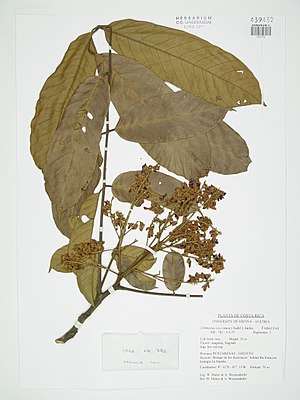Ormosia coccinea
| Ormosia coccinea | ||||||||||||
|---|---|---|---|---|---|---|---|---|---|---|---|---|

Ormosia coccinea , herable specimen |
||||||||||||
| Systematics | ||||||||||||
|
||||||||||||
| Scientific name | ||||||||||||
| Ormosia coccinea | ||||||||||||
| ( Aubl. ) Jacks. |
Ormosia coccinea is a tree in the legume family in the podaceae subfamily. It occurs in northern Brazil, in the Guyanas , in Venezuela , Colombia to Central America and in Bolivia and Peru .
description
Ormosia coccinea grows as a mostly evergreen or semi- evergreen tree up to 25–35 meters high. The trunk diameter reaches 50-100 centimeters. At the bottom of the trunk there are roots and corrugations. The bark is slightly rough and grayish with lots of lenticels .
The alternate and stalked leaves are imparipinnate with 7–11 leaflets . The short-stalked, leathery leaflets are entire and ovate to obovate or elliptical. At the top they are pointed to pointed or, less often, indented. The 10-30 centimeter long rachis and the leaf and leaflet stalks are hairy with rust. The petiole is 3–7 centimeters, the leaflet stalks 3–10 millimeters long. The leaflets, which are bare on the top, are about 7-20 centimeters long, on the underside they are lighter and, especially on the veins, somewhat rusty hairy. The veins are pinnate and raised on the underside. There are small and sloping stipules .
There are terminal and rispig- traubige formed yellow-brown hairy inflorescences. The flowers have more or less durable bracts and two bracts . The stalked, small butterfly flowers are white-purple with a brownish, rusty hairy, five-toothed and cup-shaped calyx. The 10 stamens are unequal in length, 5 shorter, 5 longer. The somewhat stalked, elongated ovary is hairy with a long, almost bald, curved stylus with a lateral, bilobed stigma .
Small, somewhat flattened and pointed, almost bald to somewhat hairy, slightly oblique-round to elongated, woody legumes with only one or two (rarely up to four) seeds are formed. If there are several seeds, they are somewhat constricted. They are about 3–6 centimeters tall and brownish. The unusual, smooth and somewhat flattened, rounded to ellipsoidal seeds are two-tone red and black and about 10-15 millimeters in size. They are similar to the seeds of the paternoster pea , but larger. The opened fruits often stay on the tree for a long time and the seeds hang out.
The seeds are considered poisonous.
Taxonomy
The first description of Basionyms Robinia coccinea was in 1775 by Jean Baptiste Christophe Fusée Aublet in Hist. Pl. Guiane: 773. The division into the genus Ormosia to Ormosia coccinea took place in 1811 by George Jackson in Trans. Linn. Soc. London 10: 360.
There are two varieties:
- Ormosia coccinea var. Coccinea
- Ormosia coccinea var. Subsimplex (Spruce ex Benth.) Rudd
use
The seeds are used as jewelry.
The wood , known as Tento or Barakaro , Baracara , is quite hard, medium-heavy and moderately resistant.
literature
- AM Polak, HR Rypkema: Major Timer Trees of Guyana A Field Guide. Tropenbos, 1992, ISBN 90-5113-013-9 , online (PDF; 8.5 MB).
- VE Rudd: The American Species of Ormosia (Leguminosae). Contrib. US Natl. Herb. 32 (5), 1965, pp. 279-384, online (PDF; 7.1 MB).
- J. Gérard, D. Guibal, S. Paradis, J.-C. Cerre: Tropical Timber Atlas. Éditions Quæ, 2017, ISBN 978-2-7592-2798-3 , pp. 882 ff, limited preview in the Google book search.
- M. Chudnoff: Tropical Timbers of the World. Agriculture Handbook 607, USDA, 1984, p. 120, limited preview in Google book search.
Web links
- Ormosia coccinea at Useful Tropical Plants.
- Ormosia coccinea at Smithsonian Tropical Research Institute.
